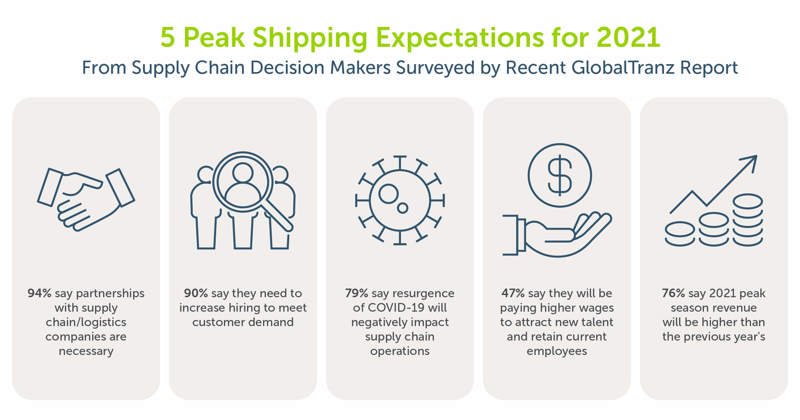Peak shipping season will look a little different this year. Luckily, there are a few things businesses can do to overcome supply chain challenges during this time.
Domestic consumer demand rose drastically when the economy started to recover after the initial coronavirus-related dip, and it has remained high since the summer of 2020. Consequently, supply chains are operating at capacity, and many are still experiencing slowdowns caused by the pandemic, making this year’s peak season unlike any other.
With the Delta variant, port congestion and high consumer demand still creating disruptions in the supply chain, planning for peak season is more important than ever.
Here’s what to expect for this year
1. The global supply chain will be taxed
GlobalTranz's most recent survey reported that 76% of supply chain decision makers believe their 2021 peak season revenue will be higher than last year’s results. To keep up with consumer demand, businesses are hiring more employees for white glove services like last-mile delivery solutions, haul away, and in-home installation
2.COVID-19 cases may surge
The Delta variant seems to be on the wane in some pockets of the United States, but Delta, and the potential for new variants, is an omnipresent issue all over the globe. COVID-19 cases will likely surge and negatively impact supply chains. Governments may reinstate lockdowns, which could exacerbate the truck driver shortage, supply chain congestion, shipping delays and the shipping container shortage.
Additionally, China’s zero-tolerance approach to COVID-19 puts further strain on already stressed global supply chains. For example, China closed the Meidong Terminal at Ningbo-Zhoushan, the world’s third busiest port, when one employee tested positive for the Delta variant. Global shipping lines are still recovering.
3. E-Commerce will continue to increase
During the pandemic, people stayed home and started shopping more online, leading to an e-commerce boom. Given that the Delta variant is still spreading, this boom will likely continue. Since businesses generally increase their costs and impose surcharges when faced with increased demand, shippers should prepare for higher peak season surcharges.
4. Supply chain disruptions will not diminish
Ships are already waiting at anchor for days outside of ports on both U.S. coasts due to severe port congestion. Belly capacity on passenger flights is low, and the shortage of workers and qualified drivers is impacting ports as well as warehouses and railways. Peak season will only place additional strain on these systems. Regardless of which transportation method shippers use, they should plan for delays and higher freight transportation costs.
5. Costs will remain elevated
Since carriers are likely to continue favoring delivering goods along the Asia-North America and Asia-Europe routes over returning to collect empty containers from South America or Africa, the container shortage will continue, and ports will likely remain congested. Despite this reduction in capacity, consumer demand will only increase during peak season, so expect shipping costs to remain high — or even rise — regardless of whether shippers transport goods by plane, ship, truck or train.
6. Supply chain technology holds the solution
While global supply chains are experiencing periodic interruptions and ongoing uncertainty, customers still expect fast shipping. Luckily, there are a few things that shippers can do to overcome these challenges.
Take lead times into account while planning shipments, as they can limit inventory, cause backlogs, and result in delayed deliveries. To handle increased peak surcharges and avoid issues caused by outdated payment methods or payment backlogs, manage payments with integrated systems. Shippers can also take more aggressive moves such as looking for freight transportation that avoids ports in the East Asia Pacific region, using alternative modes of transportation or collaborating with regional carriers to expand capacity, improve delivery times and lower the overall shipping cost per package.
Partnering with supply chain or logistics companies can help, but digitizing manual supply chain processes is the best solution. Not only will it enable shippers to centrally view and manage supply chains and more easily identify its inefficiencies, but it will also provide increased security when tracking shipments. Plus, the increased level of shipment visibility will help improve scheduling, manufacturing, and logistics. It will also encourage sustainability, as you can hold suppliers, logistics, and manufacturers more accountable for engaging in sustainable practices.
Blume Global takes a modern, holistic approach to supply chain execution, continually updating and improving capabilities so customers receive all the benefits that come from an R&D-driven organization. Click here to see Blume Global’s execution and visibility solutions in action.
contact us
Contact Us

